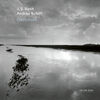Wagner : Parsifal
Herbert Kegel
Opera - Released August 12, 2008 | Brilliant Classics
Parsifal, Act 3: Nur eine Waffe taugt (Live)
Lars Cleveman
Opera - Released April 15, 2022 | Sterling
Wagner: Le vaisseau fantôme (Diapason n°615)
George London
Opera - Released June 28, 2013 | Les Indispensables de Diapason
Wagner: Parsifal Suite (Constr. A. Gourlay)
Andrew Gourlay
Classical - Released November 4, 2022 | Orchid Classics
Bruckner: Symphonies Nos. 6 & 9 – Wagner: Siegfried Idyll / Parsifal Prelude
Andris Nelsons
Classical - Released May 3, 2019 | Deutsche Grammophon (DG)
Wagner: Parsifal, WWV 111
Martha Modl
Opera - Released June 2, 2023 | Profil Edition Guenter Haenssler
Parsifal
Netherlands Radio Philharmonic Orchestra
Classical - Released May 29, 2011 | Challenge Classics
On My New Piano
Daniel Barenboim
Classical - Released November 4, 2016 | Deutsche Grammophon (DG)
Anton Bruckner: Symphony No. 3 "Wagner" - Richard Wagner: Parsifal (Kundry's Aria), Tristan und Isolde (Prelude & Liebestod)
Hans Knappertsbusch
Symphonies - Released July 1, 2017 | Praga Digitals
Wagner: Siegfried, WWV 86C & Parsifal, WWV 111 (Excerpts) [Live]
Bayreuth Festival Orchestra
Opera - Released February 4, 2022 | Profil
Bruckner : Symphony No. 9 - Wagner : Parsifal (Excerpts)
Daniele Gatti
Classical - Released November 29, 2019 | Royal Concertgebouw Orchestra
The Wagner Project
Matthias Goerne
Classical - Released November 24, 2017 | harmonia mundi
Wagner: Parsifal Orchestral Suite, Ballet Scene from Tannhauser & Prelude to Act III of Lohengrin
Neeme Järvi
Symphonies - Released May 1, 2010 | Chandos
Wagner Overtures and Preludes
Andrés Orozco-Estrada
Classical - Released August 30, 2019 | Sony Classical - Sony Music
Wagner: Parsifal - Good Friday Spell & Symphonic Synthesis Act III
Houston Symphony Orchestra
Classical - Released October 6, 2017 | Everest
Wagner: Parsifal (Orchestral Music)
Eugene Ormandy
Classical - Released March 5, 1956 | Sony Classical
Wagner: Parsifal - Good Friday Spell & Symphonic Synthesis Act III
Houston Symphony Orchestra
Classical - Released October 6, 2017 | Everest
Liszt, Wagner & Brahms: Les Préludes - Parsifal - Tristan und Isolde, Act III - 21 Hungarian Dances
San Francisco Symphony
Classical - Released May 25, 2022 | Altair
Berlioz, Wagner, Mozart, Handel & Weber: Roman Carnival, Overture - Parsifal - Act I Transformation Music - Siegfried Idyll - Le Nozze di Figaro, Overture - Eine Kleine Nachtmusik - Concerto Grosso In B Minor
Bruno Walter
Classical - Released December 17, 2021 | Infinity
J.S. Bach: Clavichord
András Schiff
Solo Piano - Released January 27, 2023 | ECM New Series











![Bayreuth Festival Orchestra Wagner: Siegfried, WWV 86C & Parsifal, WWV 111 (Excerpts) [Live]](https://static.qobuz.com/images/covers/ib/fs/i061raloqfsib_100.jpg)










 Suppose you have a more precise idea of what you want. If you are searching for the album "Bad" by Michael Jackson, type michael jackson bad. The album in question will be displayed at the top, as it is the most relevant.
Suppose you have a more precise idea of what you want. If you are searching for the album "Bad" by Michael Jackson, type michael jackson bad. The album in question will be displayed at the top, as it is the most relevant.
 By default, search results are sorted in order of relevance. The drop-down menu to the right of "Sort by" allows you to display the results in the desired order.
By default, search results are sorted in order of relevance. The drop-down menu to the right of "Sort by" allows you to display the results in the desired order.